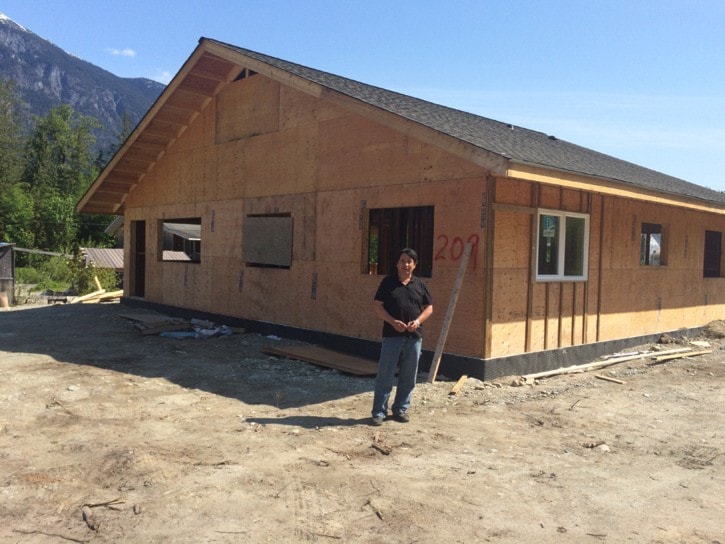Richard Hall sits behind his desk in his office of the Nuxalk Nation on the 4-Mile reservation. Surrounded by blueprints, documents, and fielding calls as we talk, he smiles as I comment on his obviously hectic job. Since taking the position of Asset Manager with the Nation one year ago, the expression “hair straight back” is a good description of his workdays.
As with many First Nations communities, the words “housing crisis” could quite easily be applied to the current situation on reserve.
There are approximately 970 people living on reserve, and many of them lack a proper home. Hall estimates that 110 new units would be filled almost immediately if they became available tomorrow, and he is under no illusions about the immensity of the task before him.
“We have situations where there are three families living in one home,” he said. “The apartments are full, there are houses badly in need of repairs. We need good quality homes for families, homes that suit their economic, social and cultural needs.”
Thankfully, Hall’s past experiences have prepared him well for the challenge ahead. A descendant of the iconic Clayton Mack, Hall said his grandparents always pushed education, and after a tumultuous 22 years logging in the bush, he found carpentry to be a perfect fit and passion.
He began working in the community in the 80s, and after completing a number of local projects more opportunities came knocking, and he left the community to return to school in preparation for a position as a building inspector for CMHC. He spent the following decade working on and off reserve all over the province, inspecting homes and making recommendations and modifications for people with disabilities. It was a rewarding experience.
“I helped people with disabilities design their homes, I worked on the downtown Eastside designing spaces for homeless people. I’ve visited every reserve in the province and I have seen the challenges throughout,” he said. “I saw and experienced a lot.”
After developing a building specification booklet and development of blueprints specific to the houses being constructed on reserve, Hall has also spearheaded the first ever carpentry field school, which now has 16 local students. “People need to be given a chance,” he asserts. “Most of these students were on social assistance, now they’re in school. Soon they’ll be building these new houses. It’s empowering and it’s exactly what this community needs.”
His vision is all encompassing and holistic to providing simple healthy housing. Hall’s plans for the new houses are practical, uncomplicated, and suited to the climate.
There are three and four-bedroom homes built in a rancher style, eliminating the challenges posed by stairs, and they include in-floor radiant heating , rain screen application and incorporated into the design of homes is a simple yet effective building science concepts. For the home owners a home maintenance plan, this is the opportunity to learn to manage the new homes.
The materials are suited for the wet weather encountered on the west coast.
“On the west coast of BC the life expectancy of a house is seven years. So what are we going to differently?” said Hall. “We’re incorporating rain screens, mold-resistant drywall, and we are thinking about the social and cultural activities people do in their homes.”
The house is also a cultural reflection of a traditional Nuxalk-style longhouse, designed to include a traditional post and beam style frontage at the entrance. Hall also said careful consideration was put into what activities people do in their homes.
“When I was up north in the interior First Nations’ communities, it wasn’t uncommon to find people skinning moose and drying hides in their basement,” he said. “Here we are boiling fish. All of these activities affect a home in different ways.”
Hall said that the approach to housing is also changing, and that people should know that they will have more control over their new homes, reflecting the changing landscape of First Nation’s housing.
“I see the Department of Indian Affairs as an agency that disables our people. That’s a stigma I want to remove,” he explained. “I want people to know that they’re an independent person and they can build a house wherever they want. All you have to do is be pro-active and follow what’s put in place for you. People have the opportunity to engage in this process.”
Hall explained that for those that qualify on their own, they can go to the lender directly. For those unqualified to gain a mortgage on their own, they can apply through the Nation for assistance, and the home will be paid for on a rent-to-own basis.
“The challenge is to evolve with the banking organizations, the internal hierarchy of Chief and Council, the membership commitment and people personal taking responsibility, being accountable for their interests,” said Hall. “People will own it and they will be responsible for it, and they will do the maintenance. This is happening across Canada, and the upcoming housing symposium is designed to help people understand the shift from the old system.”
The Nuxalk Nation’s first Housing Symposium will be held on June 17 and 18, 2015 at the Nuxalk Hall. It is intended to “promote transparency, accountability and responsibility to and for all” and includes experts representing the following trades and organizations: I.T.A BC, CMHC, First Nations Housing Solutions, RBC, and many more community partners.
The day starts at 9am and includes breakfast and lunch both days, and dinner on the first evening. It is open to the entire community and community’s abroad. All those interested are encouraged to attend.
